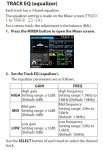TECHNINOT
Member
My dear and often most helpful colleagues,
Perhaps this question has already been posed and answered a hundred times, NONETHELESS - one of my good friends and professional singer songwriter as well as excellent recording technician (but who lives in a different country than I) insists that I must use a HIGH-PASS FILTER as a sort of bottom line opener to making better mixes. I have told him, of course, that not using a DAW system I cannot make use of plug-ins of any sort. In the title of a TASCAM FORUM article I saw the term "switchable high-pass filter" for DP-24 but there was no follow-up information to be found in the article. Its principal subject was the NEO DP-24.
Can anyone elucidate this mystery for me, please? I like the hands-on mixes I'm making with my machine but he tells me that they don't sound professional and are not, by current standards, even listenable.
As what I love the most about all of this is MAKING MUSIC, I would really like to find the simplest of solutions that can also be "listenable" )
)
Thank you dearly, whoever you are who finds the kindness of heart to answer this quest for new knowledge.
Perhaps this question has already been posed and answered a hundred times, NONETHELESS - one of my good friends and professional singer songwriter as well as excellent recording technician (but who lives in a different country than I) insists that I must use a HIGH-PASS FILTER as a sort of bottom line opener to making better mixes. I have told him, of course, that not using a DAW system I cannot make use of plug-ins of any sort. In the title of a TASCAM FORUM article I saw the term "switchable high-pass filter" for DP-24 but there was no follow-up information to be found in the article. Its principal subject was the NEO DP-24.
Can anyone elucidate this mystery for me, please? I like the hands-on mixes I'm making with my machine but he tells me that they don't sound professional and are not, by current standards, even listenable.
As what I love the most about all of this is MAKING MUSIC, I would really like to find the simplest of solutions that can also be "listenable"
Thank you dearly, whoever you are who finds the kindness of heart to answer this quest for new knowledge.

